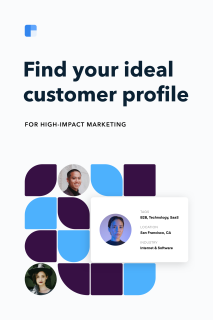Chapter 2
3 minutes
What's a data-driven ideal customer profile?
A data-driven ICP is typically defined by company data (a.k.a. firmographics). Think employees, location, industry, and technologies used. Depending on the company, you’ll see person-level data as well. Role, seniority, and location are the most common.
Using data points lets the tools in your stack automatically recognize great leads when they see them. A model determines how the lead is treated — whether to alert a salesperson in Slack when an enterprise lead visits the website or whether to send the lead through a self-serve flow, or retarget them with ads, and more.
Firmographic and demographic data can also be combined with behavioral data to reveal a lead’s interest level.
Read more about using data to define your ICP in Find the Who: Using B2B Data to Put Customers at the Heart of Your Marketing
Our approach: Reverse-engineer past success to find your data-driven ICP
We mine our past customer data to find our ICP, evaluating companies that fit our definition of a successful experience with our product (e.g., a renewal, expanded seats, daily product usage, high ACV, etc.).
This lets us study real businesses to paint a more detailed picture and be more informed when we make segments. Our customers are operating live in our product’s environment, and have traveled through our sales and marketing funnel. We can observe their in-product behavior, read up on their interactions with sales and success teams, see which roles were involved in a purchase, and reach out for direct feedback about their needs.
These are our six steps for reverse-engineering an ICP:
-
Define success criteria: What matters most to your business in its next phase of growth? For example, is it high ACV? Cross-sell potential? Ease of conversion and low CPA? Renewals and low churn?
-
Look at the past: Identify which of your current and past customers have met those success criteria (e.g., if renewals are most important to your business right now, find the customers who have renewed).
Ask your sales and success teams for their hunches about what predicts a company’s success with your product. They’ll likely have some great hypotheses for you to think about. -
Analyze for shared firmographic data points: Once you’ve identified a handful of successful customers, enrich them with firmographic Clearbit data. See whether they share any characteristics, such as industry, business model tags (SaaS, B2B vs. B2C, etc.), number of employees, annual revenue, country, Alexa rank, and technology used (Salesforce, Marketo, Segment, Drift, etc.). These are the greatest hits but there are over 100 Clearbit attributes to pick from.
-
Create a silhouette of your ideal customer: Distill down to the few attributes that best predict your success metrics.
-
Take a step back to look at your funnel and TAM: How many of these ideal customers exist in your universe? (You can use Clearbit Prospector for this through APIs or our Salesforce integration). Also, check out your funnel and determine the percentage of your leads that are ICPs. Are you spending the right proportion of your energy on ICP customers?
-
Adjust your marketing strategy and tactics: Shift your resources to focus everything on your ICP, from lead scoring to lifecycle marketing.
Join our newsletter
Engaging stories and exclusive data, designed for our best customers. One useful issue each month.
